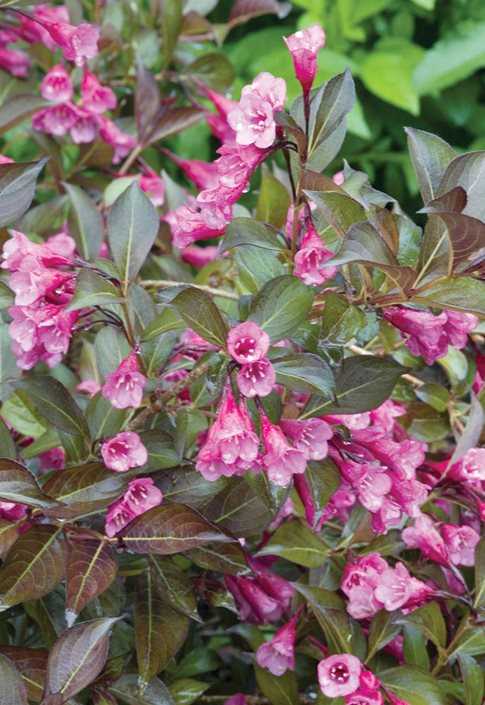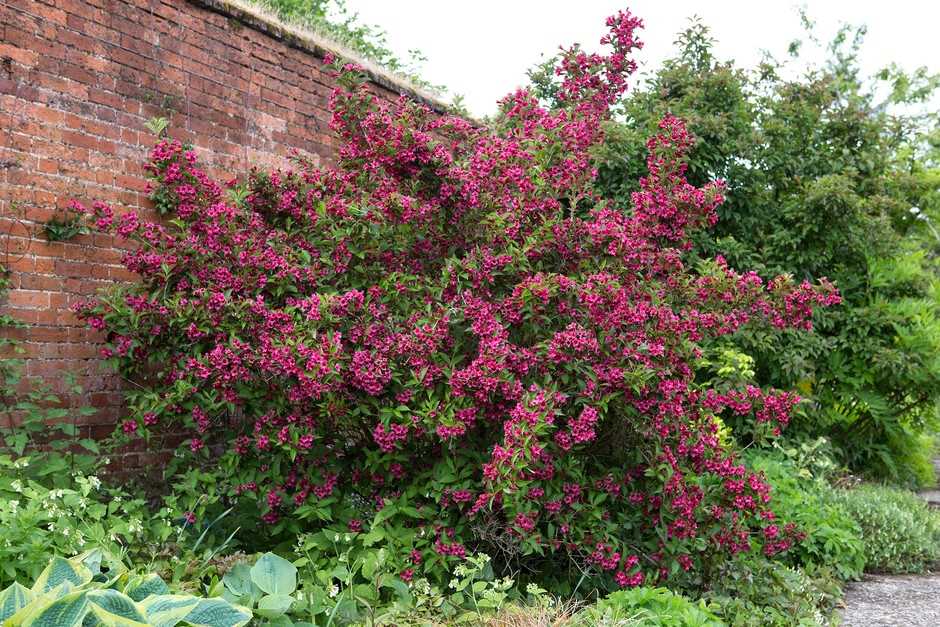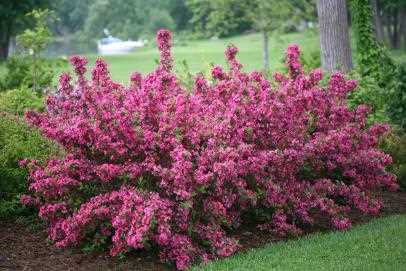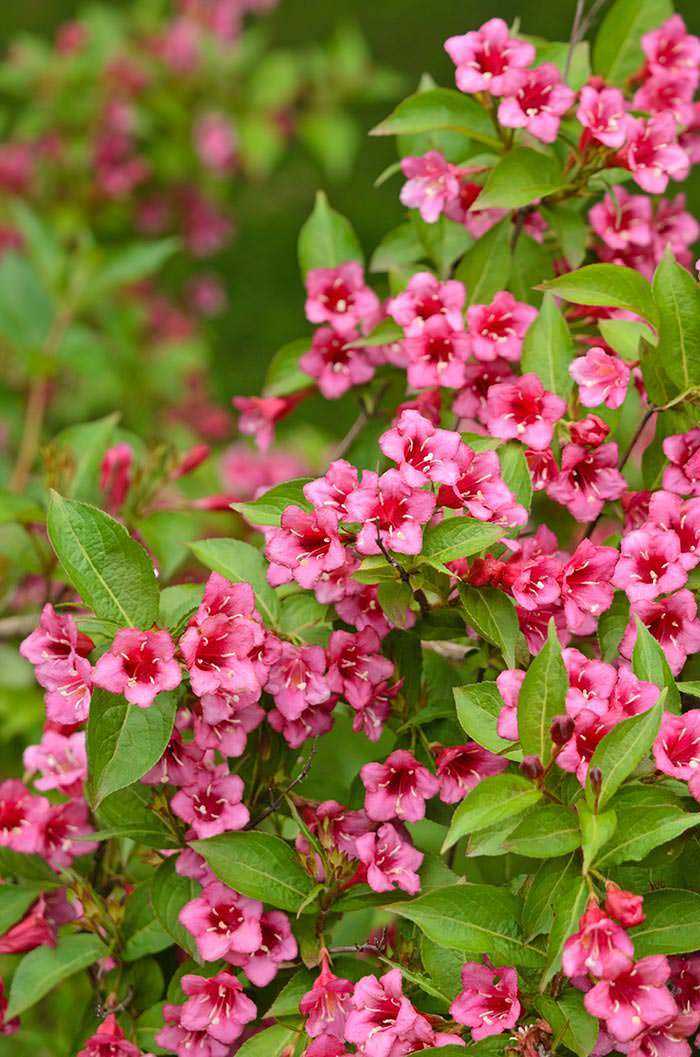- A Popular Ornamental Shrub
- Varieties
- Growing Weigela in the Garden
- Uses in Garden Designs
- Growing Weigela in Your Garden
- 1. Location:
- 2. Soil:
- 3. Planting:
- 4. Watering:
- 5. Pruning:
- 6. Fertilizing:
- 7. Pests and Diseases:
- Choosing the Right Weigela Variety
- Size
- Flower Color
- Growth Habit
- Other Considerations
- Types of Weigela Shrubs
- 1. Weigela florida
- 2. Weigela florida ‘Bristol Ruby’
- 3. Weigela florida ‘Variegata’
- 4. Weigela florida ‘Wine and Roses’
- 5. Weigela florida ‘Alexandra’
- 6. Weigela florida ‘Midnight Wine’
- Weigela florida
- Characteristics
- Cultivation
- Uses
- Weigela hybrids
- Types of Weigela hybrids
- Growing Weigela hybrids
- Weigela blooming patterns
- Spring Blooming Varieties
- Summer Blooming Varieties
- Continuous Bloomers
- Conclusion
- Landscaping with Weigela
- 1. Border Planting
- 2. Foundation Planting
- 3. Mixed Borders
- 4. Focal Point
- 5. Mass Planting
- 6. Container Planting
- 7. Attracting Pollinators
- Questions and Answers:
- How tall do Weigela plants grow?
- What are some popular types of Weigela?
- When is the best time to plant Weigela?
- How often should I water Weigela plants?
- Do Weigela plants require a lot of sunlight?
- Can Weigela be grown in containers?
- Videos: My Best Hydrangea Recommendations | Gardening with Creekside
Weigela is a beautiful flowering shrub that is popular in gardens for its vibrant blooms and attractive foliage. Native to East Asia, this versatile plant is known for its ability to thrive in a variety of climates and soil conditions. With its stunning display of colorful flowers and easy care requirements, it’s no wonder why weigela is a favorite among gardeners.
One of the standout features of weigela is its trumpet-shaped flowers, which can come in a range of colors including pink, red, white, and yellow. These flowers attract pollinators like bees and butterflies, making weigela a great choice for wildlife gardens. In addition to its blooms, weigela also has attractive foliage, with leaves that can be green, variegated, or even purplish in color.
There are several different types and varieties of weigela to choose from, each with its own unique characteristics. Some popular cultivars include ‘Bristol Ruby’, which has deep red flowers and dark green foliage, and ‘Variegata’, which features green leaves with creamy white edges. Another noteworthy variety is ‘Wine & Roses’, which has dark burgundy leaves and pink flowers. Regardless of the specific type or variety, weigela is sure to add a burst of color and interest to any garden.
A Popular Ornamental Shrub
Weigela is a popular ornamental shrub that is loved by gardeners for its beautiful flowers and foliage. Native to East Asia, it belongs to the Caprifoliaceae family and is known for its easy-to-grow nature and versatility in garden designs.
Varieties

Weigela comes in a variety of cultivars, each with its own unique features. Some popular varieties include:
- Weigela florida: This is the most common variety, known for its trumpet-shaped flowers that bloom in shades of pink, red, or white. It is a deciduous shrub that can reach a height of 5-10 feet.
- Weigela ‘Carnaval’: This variety is known for its variegated foliage, which has a mix of green, white, and pink colors. It produces pink flowers and grows up to 4-6 feet tall.
- Weigela ‘Midnight Wine’: This compact variety is popular for its dark burgundy foliage and pink flowers. It is a dwarf shrub that grows up to 1-2 feet tall.
Growing Weigela in the Garden
Weigela is a hardy shrub that thrives in full sun to partial shade. It prefers well-drained soil and can tolerate a variety of soil types. Planting Weigela in the spring or fall is ideal for its establishment.
When it comes to watering, Weigela prefers regular watering but can tolerate some drought once established. Mulching around the base of the plant can help retain moisture and suppress weeds.
Pruning Weigela is generally done after it finishes flowering. This helps promote new growth and maintain a compact shape. Removing dead or damaged branches can be done at any time.
Uses in Garden Designs
Weigela is a versatile shrub that can be used in various garden designs. It can be planted as a standalone specimen or used as a hedge or border plant. Its vibrant flowers and foliage add color and texture to gardens, making it a popular choice among landscape designers.
| Advantages | Disadvantages |
|---|---|
| Beautiful flowers | Needs regular pruning |
| Attracts pollinators | May be susceptible to some pests |
| Drought-tolerant once established | Can be invasive in some regions |
Whether used as a focal point or as part of a mixed planting, Weigela is sure to enhance the beauty of any garden.
Growing Weigela in Your Garden
Weigela is an attractive flowering shrub that is easy to grow in your garden. Here are some tips for successful cultivation:
1. Location:
Weigela plants prefer full sun to part shade. Choose a location in your garden that receives at least 6 hours of sunlight per day. This will ensure that the plants produce abundant flowers.
2. Soil:
Weigelas thrive in well-drained soil. Ensure that the soil is fertile and rich in organic matter. If your soil is heavy and clay-like, consider amending it with compost or other organic materials to improve drainage.
3. Planting:
Plant weigelas in the early spring or fall. Dig a hole that is wider and deeper than the plant’s root ball. Place the plant in the hole, backfill with soil, and gently firm the soil around the roots.
4. Watering:
Keep the soil consistently moist, especially during the plant’s first year. Water deeply rather than shallowly, allowing the water to penetrate the root zone. Avoid overwatering, as weigelas are susceptible to root rot.
5. Pruning:
Weigelas benefit from regular pruning to maintain their shape and promote abundant flowering. Prune your plants in the late winter or early spring before new growth begins. Remove any dead or damaged branches, as well as any crossing or crowded branches.
6. Fertilizing:
Apply a balanced, slow-release fertilizer in the early spring to provide essential nutrients for growth and flowering. Follow the instructions on the fertilizer packaging for the appropriate application rates.
7. Pests and Diseases:
Weigelas are generally resistant to pests and diseases. However, they can occasionally be affected by aphids, spider mites, or powdery mildew. Monitor your plants regularly and take appropriate action if any problems occur.
By following these tips, you can successfully grow weigelas in your garden and enjoy their beautiful flowers for years to come. Happy gardening!
Choosing the Right Weigela Variety
When selecting a weigela variety for your garden, it’s important to consider several factors such as the size of your garden, the desired color of the flowers, and the overall aesthetic you want to achieve. Here are some key points to consider when choosing the right weigela variety:
Size
Weigelas come in various sizes, ranging from compact shrubs to larger specimens. Consider the available space in your garden and how big you want the weigela to grow. Compact varieties, such as ‘Minuet’ or ‘Midnight Wine’, are perfect for smaller gardens or containers, while larger varieties like ‘Wine and Roses’ or ‘Red Prince’ can be a focal point in larger landscapes.
Flower Color
Weigelas produce flowers in a range of colors, including pink, red, and white. Think about the color scheme of your garden and choose a weigela variety that will complement it. For example, if you have a garden with predominantly warm-colored flowers, a weigela with pink or red flowers, such as ‘Bristol Ruby’ or ‘Carnaval’, would create a striking contrast. Alternatively, if your garden has a cooler color palette, a white-flowered variety like ‘White Knight’ or ‘Ghost’ would be an elegant choice.
Growth Habit
Consider the growth habit of the weigela variety you are considering. Some varieties have an upright growth habit, while others have a more spreading form. If you’re looking to create a hedge or a screen, an upright variety like ‘My Monet’ or ‘Sonic Bloom’ would be suitable. However, if you want to fill a wider space or create a cascading effect, a spreading variety like ‘Pink Princess’ or ‘Variegata’ would be more appropriate.
Other Considerations
Other factors to consider when choosing a weigela variety include its hardiness, resistance to diseases, and fragrance. Check the hardiness zone of the variety to ensure it can thrive in your climate. Look for disease-resistant varieties, such as ‘Java Red’ or ‘Spilled Wine’, to minimize the risk of common rose diseases. If you want a weigela with a pleasant fragrance, consider varieties like ‘Candida’ or ‘Wings of Fire’.
By considering these factors, you can select the right weigela variety that will thrive in your garden and enhance its beauty.
Types of Weigela Shrubs
Weigela shrubs come in various types and varieties, each with its unique characteristics and features. Here are some popular types of Weigela shrubs:
1. Weigela florida
This is the most commonly grown type of Weigela shrub. It is known for its abundant and showy flowers, which range in color from pink to red. Weigela florida shrubs typically bloom in late spring or early summer and attract pollinators like bees and butterflies.
2. Weigela florida ‘Bristol Ruby’

Bristol Ruby is a popular cultivar of Weigela florida that features deep red flowers. It is a compact shrub with a height and spread of around 4-6 feet. This cultivar blooms profusely in spring and may produce some additional flowers sporadically throughout the summer.
3. Weigela florida ‘Variegata’
The Variegata cultivar of Weigela florida is known for its attractive variegated foliage. The leaves have a green center and creamy-white edges, adding visual interest to the shrub even when it is not blooming. The variegated foliage contrasts beautifully with the pink or red flowers that appear in spring.
4. Weigela florida ‘Wine and Roses’
Wine and Roses is a popular cultivar of Weigela florida that stands out for its dark purple foliage. The leaves of this shrub are deep burgundy, providing a striking backdrop to the pink flowers that appear in spring. This cultivar also tends to have a more compact and mounding growth habit.
5. Weigela florida ‘Alexandra’
The Alexandra cultivar is another notable variety of Weigela florida. It features deep pink flowers and has a more compact and spreading growth habit compared to other types. This cultivar is highly attractive to pollinators and can be a great addition to any wildlife-friendly garden.
6. Weigela florida ‘Midnight Wine’

Midnight Wine is a dwarf cultivar of Weigela florida, known for its small size and dark burgundy foliage. It forms a dense, mounding shape and produces pink flowers in spring. This compact shrub is perfect for small gardens or containers.
These are just a few examples of the many types and varieties of Weigela shrubs available. Whether you prefer showy flowers, variegated foliage, or unique growth habits, there is a Weigela shrub to suit your taste and garden needs.
Weigela florida
Weigela florida is a deciduous shrub native to Asia. It is commonly known as the “Old-fashioned Weigela” or “Weigela Bush.” This plant has been cultivated for its beautiful flowers and attractive foliage.
Characteristics

- Weigela florida can grow up to 6 to 8 feet tall and wide, making it a medium-sized shrub.
- Its leaves are ovate to elliptic in shape and are 2 to 4 inches long. They are usually green but can turn reddish-purple in the fall.
- The flowers of Weigela florida are tubular-shaped and are usually pink or red. They appear in clusters in late spring to early summer and attract hummingbirds and butterflies.
- After the flowers fade, the plant produces small capsules that contain numerous seeds.
Cultivation
Weigela florida is a relatively easy plant to grow. Here are some tips for successful cultivation:
- Plant Weigela florida in well-draining soil that is rich in organic matter. It prefers a slightly acidic to neutral pH.
- Choose a location that receives full sun to partial shade. Weigela florida can tolerate some shade, but it will have fewer flowers.
- Water the plant deeply and regularly, especially during periods of drought.
- Prune Weigela florida after it has finished flowering to maintain its shape and promote more blooms.
- Fertilize the plant in early spring with a balanced fertilizer to encourage healthy growth.
Uses
Weigela florida is commonly grown as an ornamental plant in gardens and landscapes. Its showy flowers and attractive foliage make it a popular choice for adding color and interest to the landscape.
| Common Name | Weigela florida |
|---|---|
| Family | Caprifoliaceae |
| Genus | Weigela |
| Species | florida |
| Origin | Asia |
Weigela hybrids
Weigela hybrids are a popular choice among gardeners due to their vibrant and abundant flowers. These hybrids are the result of crossbreeding different species of Weigelas, resulting in new and unique varieties.
Types of Weigela hybrids
There are several types of Weigela hybrids available, each with its own characteristics:
- Weigela florida hybrids: These hybrids are known for their showy, trumpet-shaped flowers that come in various colors such as pink, red, and white. They have a compact growth habit and are perfect for smaller gardens.
- Weigela florida ‘Wine & Roses’: This hybrid is famous for its dark burgundy foliage, which contrasts beautifully with its pink flowers. It adds a dramatic touch to any garden and is often used as a focal point.
- Weigela florida ‘Variegata’: This hybrid features variegated leaves with creamy-white edges, providing a striking visual interest even when not in bloom. The pink flowers complement the foliage and create a stunning display.
- Weigela florida ‘Alexandra’: With its deep pink flowers and compact growth habit, this hybrid is a favorite choice for borders and container gardening. It attracts butterflies and hummingbirds, adding life to the garden.
Growing Weigela hybrids
Weigela hybrids are relatively easy to grow and maintain. Here are some tips for successful cultivation:
- Location: Choose a sunny or partially shaded spot in your garden for planting Weigela hybrids. They prefer well-draining soil but can tolerate a wide range of soil types.
- Planting: Dig a hole twice as wide and deep as the root ball of the plant. Place the Weigela hybrid in the hole, making sure the top of the root ball is level with the soil surface. Backfill the hole and water thoroughly.
- Watering: Keep the soil evenly moist, especially during the first growing season. Once established, Weigela hybrids are moderately drought-tolerant but still benefit from regular watering.
- Pruning: Prune Weigela hybrids immediately after they finish flowering. Remove any dead, damaged, or overgrown branches to maintain a neat and tidy appearance. Light pruning can also be done in late winter to promote better blooming.
- Fertilizing: Apply a balanced fertilizer in early spring to encourage healthy growth and abundant flowering. Follow the manufacturer’s instructions for the appropriate dosage.
By choosing the right Weigela hybrid and providing it with proper care, you can enjoy a stunning display of colorful flowers in your garden for years to come.
Weigela blooming patterns
Weigela is a deciduous flowering shrub known for its beautiful and abundant blossoms. The blooming patterns of Weigela can vary depending on the specific variety and environmental conditions. Here are some common blooming patterns to expect when growing Weigela in the garden:
Spring Blooming Varieties
- Weigela florida: This is the most popular species of Weigela and it typically blooms in late spring. The flowers are tubular in shape and come in various colors including pink, red, and white.
- Weigela florida ‘Alexandra’: This variety of Weigela blooms in spring and produces an abundance of deep pink flowers. It is known for its vigorous growth and attractive foliage.
- Weigela florida ‘Bristol Ruby’: Bristol Ruby is another spring blooming variety of Weigela that features deep red flowers. It is a compact shrub and ideal for smaller gardens.
Summer Blooming Varieties
- Weigela florida ‘Variegata’: This variety blooms in late spring to early summer and has attractive variegated foliage. The flowers are pink and create a stunning contrast against the green and white leaves.
- Weigela florida ‘My Monet’: My Monet is a dwarf variety that blooms throughout the summer. The pink flowers are complemented by its variegated leaves, making it an excellent choice for borders or containers.
Continuous Bloomers
There are a few Weigela varieties that have an extended blooming period, often starting in spring and continuing until fall:
- Weigela florida ‘Sonic Bloom’: Sonic Bloom is a reblooming variety that produces flowers repeatedly from late spring to frost. The blooms are a vibrant red and add color to the garden for several months.
- Weigela florida ‘Midnight Wine’: Midnight Wine is a compact Weigela variety with burgundy foliage and deep pink flowers. It blooms from late spring to early fall and is a great choice for adding color and texture to any garden.
Conclusion
Whether you prefer spring blooming varieties or those that continue to bloom throughout the summer, Weigela offers a wide range of options to fit your gardening needs. With its stunning blossoms and attractive foliage, Weigela is a versatile and beautiful addition to any garden.
Landscaping with Weigela
Weigela is a versatile and beautiful shrub that can be used in various landscaping applications. Its vibrant flowers and attractive foliage make it a popular choice for adding color and texture to gardens, borders, and pathways. Here are some ideas on how to incorporate weigela into your landscape:
1. Border Planting
Weigela’s compact and bushy growth habit makes it an excellent choice for border plantings. You can create a stunning visual impact by planting weigela along the edges of flower beds, pathways, or driveways. Its colorful flowers will add vibrancy and interest to your landscape.
2. Foundation Planting
Weigela can be used as a foundation plant around the base of your home or buildings. Its upright and arching branches can provide a soft and inviting backdrop for your house. Choose a variety of weigela that matches the color scheme and style of your home for a cohesive and harmonious look.
3. Mixed Borders
Combine different types of weigela with other flowering shrubs, perennials, and ornamental grasses to create a dynamic and visually appealing mixed border. The various colors, heights, and textures of the plants will create a layered and textured effect, adding depth and interest to your landscape.
4. Focal Point
Choose a large and showy weigela variety and make it the focal point of your garden. Plant it in a prominent location, such as the center of a circular flower bed or at the end of a pathway. The vibrant colors and graceful form of the weigela will draw attention and make a bold statement in your landscape.
5. Mass Planting
If you have a large area that needs to be filled with color, consider mass planting weigela. Plant multiple shrubs close together to create a dense and eye-catching display. This can be especially effective in commercial landscapes, parks, or large gardens.
6. Container Planting
Weigela can also be grown in containers, making it a great choice for patios, balconies, or small gardens. Choose a compact or dwarf variety that is suitable for container growing and plant it in a large pot with well-draining soil. Place the container in a sunny location and enjoy the beautiful blooms and foliage.
7. Attracting Pollinators
Weigela flowers are a favorite of bees, butterflies, and hummingbirds. By planting weigela in your landscape, you can attract these pollinators and create a thriving ecosystem. The buzzing and fluttering of these creatures will bring life and movement to your garden.
With its versatility and beauty, weigela is a wonderful addition to any landscape. Whether you choose to use it as a border plant, foundation plant, or focal point, weigela will add color, texture, and interest to your outdoor space.
Questions and Answers:
How tall do Weigela plants grow?
Weigela plants can grow anywhere from 3 to 10 feet tall, depending on the variety and growing conditions.
What are some popular types of Weigela?
Some popular types of Weigela include ‘Wine and Roses’, ‘Bristol Ruby’, and ‘Variegata’.
When is the best time to plant Weigela?
The best time to plant Weigela is in the spring or fall, when the weather is mild and there is less stress on the plant.
How often should I water Weigela plants?
Weigela plants should be watered deeply once or twice a week, depending on the weather and soil conditions.
Do Weigela plants require a lot of sunlight?
Weigela plants prefer full sun to partial shade, so it’s important to place them in a location where they will receive at least 6 hours of direct sunlight per day.
Can Weigela be grown in containers?
Yes, Weigela can be grown in containers as long as the container is large enough to accommodate the plant’s root system and the appropriate soil and drainage is provided.







